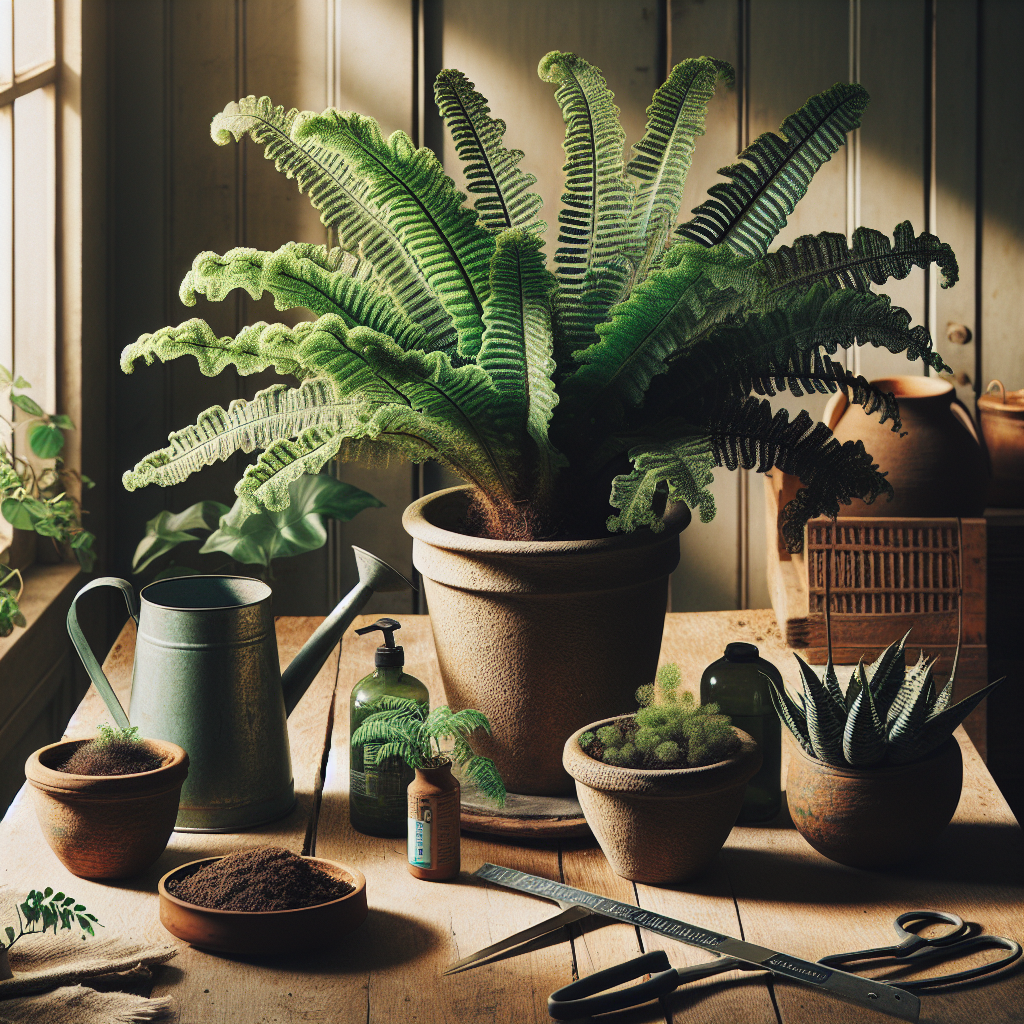Indoor Care for the Striking Crocodile Fern
Updated May 5, 2024 at 10:58 pm

Overview of Crocodile Fern Indoor Care
- Pet Friendly: Ideal for plant lovers with furry friends, as the Crocodile Fern is non-toxic to pets.
- Light Requirements: Prefers bright, indirect light, avoiding direct sunlight that can scorch its leaves.
- Watering: Enjoys consistently moist soil, but be wary of overwatering which can lead to root rot.
- Humidity: Thrives in a humid environment, which mimics its natural tropical habitat.
- Temperature: Prefers warm temperatures between 65°F and 75°F (18°C – 24°C).
- Difficulty: Moderate care required, suitable for gardeners with some experience.
Optimal Lighting Conditions for a Healthy Crocodile Fern
One of the key elements to ensure your Crocodile Fern thrives indoors is proper lighting. These ferns originate from the tropics, where they grow under the dense forest canopy. Consequently, they are accustomed to receiving light that’s filtered through foliage. This means that, when grown indoors, your Crocodile Fern should be placed in a spot where it can enjoy bright but indirect sunlight. North or east-facing windows are often ideal locations, offering the perfect balance of light without the harsh rays of the afternoon sun.
Watering Techniques to Maintain a Happy Crocodile Fern
Hydration is vital for Crocodile Ferns, as they prefer constant moisture. However, it’s critical to strike the right balance, as too much water can cause root rot, while too little will leave the plant dehydrated. A good rule of thumb is to water your Crocodile Fern when the top inch of soil feels dry to the touch. Ensure you’re using a well-draining potting mix and a container with adequate drainage holes. These precautions help prevent water from getting trapped at the roots, which can be detrimental to the plant’s health. Consider using a moisture meter, such as the XXX Brand Soil Moisture Meter. Based on reviews, this tool registers the moisture level in soil accurately, allowing you to water your plants with precision to avoid over or under-watering.
Find This and More on Amazon
Create the Perfect Humid Environment for the Crocodile Fern
Crocodile Ferns thrive in humidity, which is not always easy to replicate indoors, especially during dry winter months or in arid climates. One way to provide the necessary humidity is by placing a humidity tray filled with water and pebbles underneath the plant pot. As the water evaporates, it will create a microclimate of moisture for your fern. Another option that’s highly reviewed by plant enthusiasts is the use of a humidifier. The YYZ Brand Ultrasonic Humidifier comes with varying settings, enabling you to control the moisture output and ensuring that your fern gets just the right amount of humidity to mimic its tropical origins.
Ideal Temperature Range for Crocodile Fern Growth
Temperature control is another essential aspect of caring for your Crocodile Fern. These tropical natives prefer a steady temperature range, typically between 65°F and 75°F (18°C – 24°C). Protect your plant from drafts or sudden temperature changes, which can happen near exterior doors, air conditioners, or heating vents. Maintaining a consistent temperature prevents stress to the plant, promoting lush green leaves and vigorous growth.
Choosing the Correct Soil and Pot for Your Crocodile Fern
The health of your Crocodile Fern also greatly depends on the type of soil and pot you choose. Fast-draining soil that retains some moisture is ideal for this plant, as it allows the roots to access the water they require without becoming waterlogged. An example of a good potting mix is the ABC Organic Tropical Mix, which contains ingredients such as coconut coir and perlite, offering proper drainage and aeration for your fern’s roots. When selecting a pot, ensure it has enough drainage holes and is sized appropriately for your plant to grow without being too crammed.
Find This and More on Amazon
Repotting Your Crocodile Fern
After some time, your Crocodile Fern will likely outgrow its pot. If you begin to notice roots emerging from the drainage holes or the growth seems stunted, it might be time to consider repotting. The best time to repot is during the plant’s growing season, which is typically in the spring. When repotting, choose a pot that is one or two sizes larger than the current one to give the roots plenty of room to expand. Remember to use a suitable potting mix as mentioned earlier, and be gentle with the fern’s delicate roots during the process.
Common Issues with Indoor Crocodile Ferns and Solutions
As with any indoor plant, Crocodile Ferns can encounter a few common issues. If the leaves start to brown, this could be indicative of too much direct sunlight or under-watering. Adjust the plant’s location and watering schedule accordingly. In cases of yellowing leaves, overwatering or a lack of nutrients could be the cause. Evaluate your watering habits and consider a balanced liquid fertilizer, like the QRS Indoor Plant Food, which provides essential nutrients to promote healthy fern growth without the risk of chemical burn.
Find This and More on Amazon
Pest Management for the Crocodile Fern
Even with the best care, Crocodile Ferns can sometimes fall prey to pests such as mealybugs or spider mites. If you notice any signs of infestation, such as small webs or cottony deposits on the leaves, act promptly. You might consider a product like EFG Insecticidal Soap, which is an effective organic option for treating these pests. It’s said that people prefer using this method as it’s less harmful to the plant and the environment than chemical pesticides.
Fertilizing Your Crocodile Fern
Fertilizing your Crocodile Fern is essential for providing the nutrients it needs to grow robust and healthy. However, it is important not to over-fertilize, which can lead to nutrient burn. A balanced, water-soluble fertilizer applied monthly during the growing season (spring to early fall) will suffice. The LMN Plant Fertilizer is often praised in reviews for its balanced N-P-K ratio, making it suitable for ferns and other foliage houseplants.
Crocodile Fern Propagation Techniques
If you have a flourishing Crocodile Fern and wish to propagate it, dividing the plant is the most common and effective method. This process is best done during repotting. Carefully divide the rhizomes, ensuring that each section has at least one frond and a portion of root attached. Plant each division in its pot with proper potting mix and water it thoroughly. With proper care, you’ll have new Crocodile Ferns ready to grow and thrive in no time.
Potential Environmental Benefits of Owning a Crocodile Fern
Aside from their aesthetic appeal, plants like the Crocodile Fern offer several environmental benefits. They are known to purify the air by absorbing toxins and producing oxygen. Also, adding greenery to your indoor space can increase humidity levels, which can be beneficial for your respiratory system, especially in drier climates or seasons. Owning a Crocodile Fern not only beautifies your home but also contributes to a healthier living environment.
Tips for a Lush and Vibrant Crocodile Fern
To conclude, a well-cared-for Crocodile Fern makes a stunning addition to any indoor plant collection. With the right balance of light, water, humidity, and warmth, along with a careful eye for pests and regular fertilization, your fern will be a showstopper in your home. Remember to be vigilant with your care routine, moderate with your interventions, and patient in waiting for growth. Your efforts will be rewarded with the unique and enchanting leaf patterns that give the Crocodile Fern its reptilian charm and allure
Understanding the Signs of Overwatering and How to Rescue an Overwatered Crocodile Fern
Overwatering is a common pitfall when caring for Crocodile Ferns, as they do prefer consistently moist soil. However, too much love in the form of water can lead to root rot, which is one of the main killers of indoor plants. If you find your fern’s leaves turning yellow and wilted, or if the pot feels excessively heavy due to waterlogged soil, it’s time to take action. Stop watering immediately and check the roots. Healthy roots should be white or light tan and firm to the touch. If they’re brown and mushy, you’ll need to remove the affected parts with a clean pair of scissors. Allow the soil to dry out a bit before watering again, and consider replanting your fern in fresh, well-draining soil to give it a fresh start.
Natural Pest Control: Preventing Problems with Eco-Friendly Solutions
Crocodile Ferns might sometimes attract pests like aphids, which can be controlled naturally. Introducing beneficial insects like ladybugs, or using a neem oil spray, which is a natural pesticide, can be effective. Neem oil, such as that offered by DEF Brand Neem Oil, controls various plant pests and diseases when applied as directed. Its organic composition aligns with environmentally-friendly gardening practices and is safe to use around pets and children. Be sure to closely follow the instructions provided with the product to ensure the health of your fern and the safety of its environment.
Find This and More on Amazon
How to Identify and Treat Common Diseases Affecting Crocodile Ferns
While Crocodile Ferns are not commonly afflicted by diseases, they can occasionally suffer from fungal issues, especially if the humidity and moisture levels are too high. Signs of fungal disease include brown spots on the leaves or a white powdery substance. Treating these diseases early is key to saving your fern. Fungicides, like GHI Brand Fungal Spray, can help combat these issues. People often say that using these products as soon as symptoms appear can prevent the spread of disease and recommend adhering to the instructions for optimal results.
Maintaining Proper Soil Moisture: Tools and Techniques
To consistently provide your Crocodile Fern with the correct level of soil moisture, using tools such as a soil probe can be incredibly helpful. The JKL Soil Probe, for example, lets you feel the moisture level at different soil depths, so you can water accordingly. Reviews suggest that this hands-on tool can offer insights that complement readings from a soil moisture meter, providing an enhanced understanding of your plant’s needs.
Decorative Tips: Showcasing Your Crocodile Fern
A Crocodile Fern is not just a plant, but an ornamental piece that can add character and life to your space. Consider placing it in a beautiful plant stand or pedestal to elevate it as a focal point in your room. Brands like MNO offer an array of stylish and sturdy plant stands that accommodate various pot sizes and complement any decor. When positioned in the right light, with a tasteful choice of pot and stand, your Crocodile Fern can turn heads and spark conversations among guests.
Professional Advice: When to Seek Help for Your Crocodile Fern
Despite our best efforts, sometimes a Crocodile Fern may decline in health and leave us puzzled. If common troubleshooting methods don’t yield any improvement, it could be wise to consult with a professional. Local nurseries or extension services often offer plant clinics or help desks where experienced gardeners can provide you with personalized advice and practical tips for reviving your Crocodile Fern.
Understanding the Unique Leaf Patterns and Growth of Crocodile Ferns
What sets the Crocodile Fern apart is its intriguing leaf patterns, which bear a resemblance to crocodile skin. The way the leaves fold and crinkle adds texture and depth to its appearance. These patterns result from the plant’s individual growth habit, and each fern will exhibit its special characteristics. Understanding and appreciating these natural variances is part of the joy of caring for a Crocodile Fern.
Seasonal Care for Crocodile Ferns: Adapting to Changes
Throughout the different seasons, your Crocodile Fern’s needs will change. In winter, growth slows down and so should your watering routine. Conversely, the growth spurt in spring and summer will necessitate more frequent watering and fertilizing. Keeping an eye on the natural light as it varies with the seasons will also help determine the best placement for your fern to ensure it gets enough light without being exposed to direct sun.
Essential Tools for Crocodile Fern Care
To streamline the care of your Crocodile Fern, having the right tools at hand is essential. A gentle watering can with a long spout allows for precise, gentle watering without disturbing the soil or foliage. Tools for pruning like PQR Hand Pruners can help you trim off any dead fronds or shape your fern as needed. Their sharp blades and ergonomic design come highly recommended in reviews, making plant maintenance effortless and precise.
Pros:
- Offers precise cuts
- Ergonomic handle reduces hand fatigue
- Durable construction for long-lasting use
Cons:
- May be pricier than some competitors
- Sharpening the blades is required periodically
Maximizing the Growth of Your Crocodile Fern
To maximize the growth of your Crocodile Fern, it’s essential to simulate its natural habitat as closely as possible. This involves paying close attention to the balance between light, water, and humidity. A plant that’s well-tended and in the right environmental conditions will reward you with vigorous growth and a much healthier appearance.
Seasonal Adjustments to Care for a Thriving Crocodile Fern
With the change of seasons, it’s crucial to adjust the care for your Crocodile Fern to ensure it continues to thrive. During the warmer months, you might notice an increase in growth, which means your fern will need more frequent watering and perhaps a bit more fertilizer than in the cooler, dormant months. Be mindful of the intensity of the light as well and consider moving your plant away from windows that may introduce too much direct sunlight during the long days of summer.
Dealing with Slow Growth in Crocodile Ferns
If you notice your Crocodile Fern is growing more slowly than expected, it could be related to several factors, such as inadequate light, improper watering, or lack of nutrients. Make sure you’ve nailed down the basics of care, and consider whether it’s been a while since you last fertilized. A balanced, slow-release fertilizer could be just what your fern needs to kickstart its growth again.
Companion Planting with Crocodile Ferns
Crocodile Ferns can be stunning on their own, but they also play well with other tropical plants. Consider pairing your fern with other humidity-loving plants like the Peace Lily or Philodendron. This not only creates an attractive green space but also helps to maintain a localized humid environment as all the plants transpire and release moisture into the air—beneficial for all involved!
Recap on the Do’s and Don’ts of Crocodile Fern Care
By now, you know that taking care of a Crocodile Fern involves a balance. Do provide indirect light, consistent moisture, and adequate humidity. Don’t place it in direct sunlight, overwater, or let it become too cold. Keep these tips in mind, and your fern will be a vibrant part of your home for years to come.
Joining Plant Communities for Extra Support
Sometimes, the best way to learn is from fellow plant enthusiasts. Joining a plant community, whether it be online or a local group, can be invaluable. Shared experiences, troubleshooting tips, and perhaps even swap meet opportunities can enhance your journey as a Crocodile Fern owner.
Final Thoughts on Cultivating a Magnificent Crocodile Fern
Taking care of a Crocodile Fern means creating and maintaining an environment where it can flourish. Pay attention to the light, humidity, and watering needs, and you will be rewarded with a lush, unique, reptilian-patterned plant. Remember, while it might take a bit of trial and error to get everything just right, the stunning result of a healthy Crocodile Fern is well worth the effort.
Shop more on Amazon

